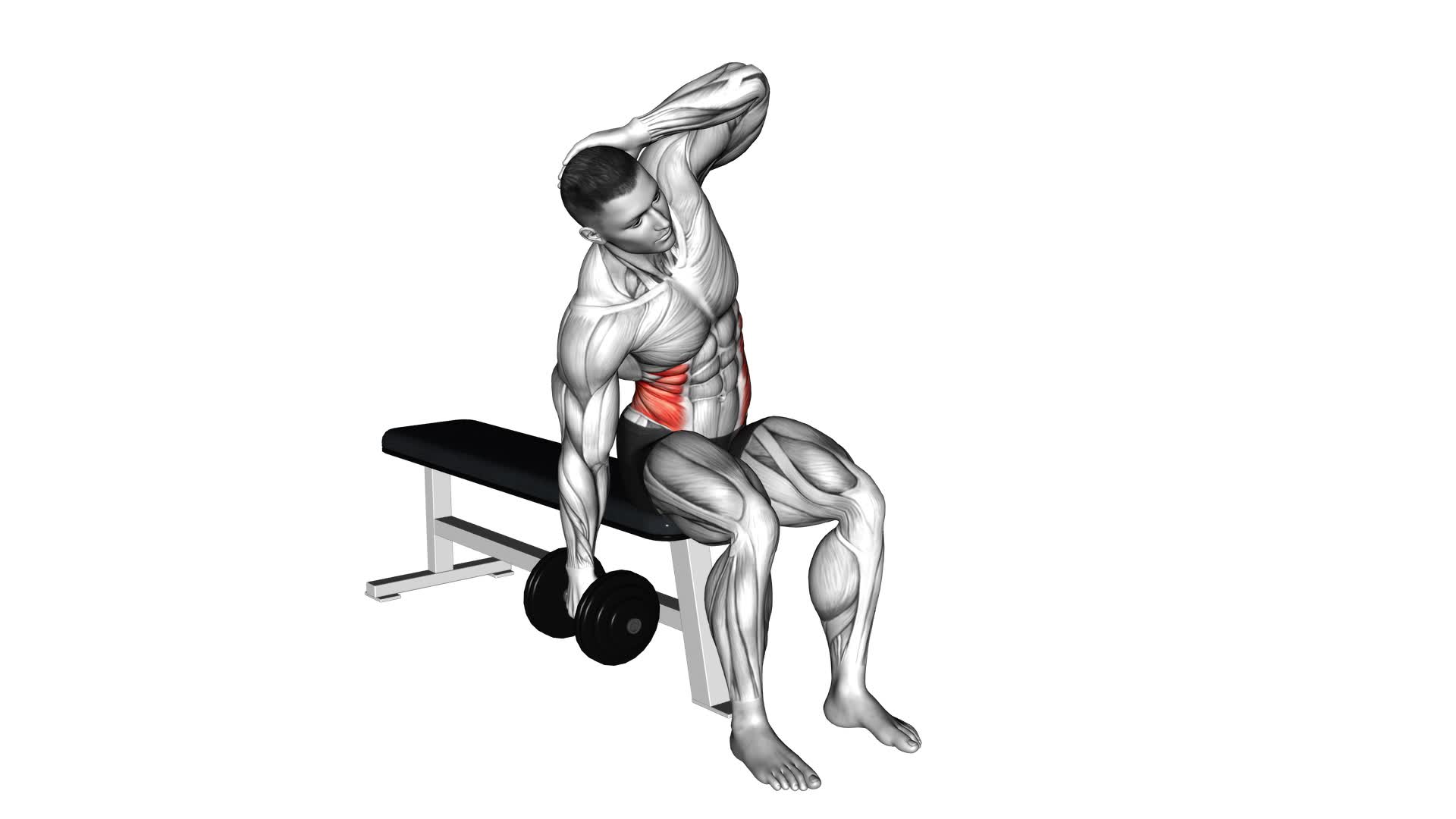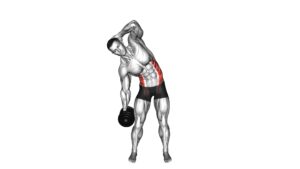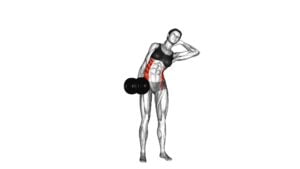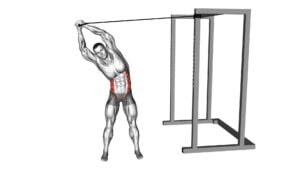Dumbbell Seated Side Bend (male) – Video Exercise Guide & Tips

Looking to strengthen your core and sculpt those obliques? Look no further than the dumbbell seated side bend.
Watch This Exercise Video
In this exercise, you'll target those hard-to-reach muscles, improving your stability and posture.
With a step-by-step video guide and helpful tips, you'll learn the proper form and technique to maximize your results.
Get ready to feel the burn and achieve those killer abs. Let's dive in and get started!
Key Takeaways
- Targets hard-to-reach muscles
- Improves stability and posture
- Strengthens core and oblique muscles
- Enhances overall core strength and stability
Benefits of the Dumbbell Seated Side Bend
Improve your core strength and stability with the dumbbell seated side bend. This exercise offers numerous benefits for weightlifters, particularly when it comes to working the oblique muscles. Incorporating the dumbbell seated side bend into your workout routine can help you achieve a stronger and more defined midsection.
One of the key benefits of this exercise is its ability to target the oblique muscles. These muscles, located on the sides of your abdomen, play a crucial role in stabilizing your torso and supporting your spine. By engaging these muscles through the dumbbell seated side bend, you can enhance your overall core strength and stability.
Additionally, the dumbbell seated side bend is an effective way to build strength in your lateral muscles. These muscles, located on the sides of your body, are responsible for bending and twisting motions. Strengthening these muscles can improve your overall athletic performance and make everyday movements easier.
Furthermore, this exercise also helps to improve your posture by strengthening the muscles that support your spine. By developing a stronger core, you can maintain better alignment and reduce the risk of back pain or injury.
Proper Equipment and Setup
To properly perform the dumbbell seated side bend exercise, you'll need a pair of dumbbells. Here are some equipment options and modifications for beginners to ensure proper setup:
- Dumbbells: Choose dumbbells that are appropriate for your fitness level. Start with lighter weights and gradually increase as you become more comfortable with the exercise. It's important to select dumbbells that you can comfortably hold in each hand while maintaining proper form.
- Bench or Chair: Find a stable and sturdy bench or chair to sit on during the exercise. Ensure that it's at a height that allows your feet to be flat on the ground and your knees to be at a 90-degree angle. This will provide stability and support for your body during the movement.
- Mat: Consider using a mat or towel to provide cushioning for your backside while seated. This can help prevent discomfort or pressure points during the exercise.
Modifications for beginners:
- Start with lighter weights or no weights at all: If you're new to this exercise, it's advisable to begin without any weights or with lighter dumbbells. Focus on mastering the proper form and technique before gradually increasing the weight.
- Perform the exercise without a bench or chair: If sitting on a bench or chair is challenging for you, you can perform the dumbbell seated side bend while sitting on the floor. This modification can provide additional stability and support.
- Reduce the range of motion: If you find it difficult to bend to the side comfortably, you can reduce the range of motion by performing smaller bends until you build up strength and flexibility.
Step-by-Step Guide to Perform the Exercise
Now, let's walk you through the step-by-step guide to perform the dumbbell seated side bend exercise correctly.
Pay attention to the correct form tips to maximize the benefits and avoid any common mistakes that may hinder your progress.
Correct Form Tips
Hold a dumbbell in one hand and sit upright on a bench to begin performing the Dumbbell Seated Side Bend exercise.
Here are some correct form tips to ensure you perform the exercise safely and effectively:
- Keep your back straight and engage your core throughout the movement.
- Slowly lower the dumbbell towards the floor, focusing on the stretch on the opposite side of your obliques.
- Avoid using excessive momentum or jerking motions, as this can lead to injury.
By following these tips, you can prevent common mistakes and reduce the risk of injury while performing the Dumbbell Seated Side Bend exercise.
Remember to start with a lighter weight and gradually increase as you become more comfortable with the movement. Always listen to your body and stop if you feel any pain or discomfort.
Common Mistakes to Avoid
Avoid arching your back excessively during the Dumbbell Seated Side Bend exercise to maintain proper form and prevent injury.
One common mistake to avoid is using too much weight. It's important to start with lighter dumbbells and gradually increase the weight as you become more comfortable and confident with the exercise.
Another common mistake is moving too quickly or with jerky movements. This can put strain on your muscles and increase the risk of injury. Instead, focus on slow and controlled movements to effectively target your obliques.
Additionally, it's important to keep your core engaged throughout the exercise and avoid rounding your shoulders.
If you find it difficult to maintain proper form, you can modify the exercise by using a resistance band instead of dumbbells. This can help reduce the strain on your back while still targeting your obliques effectively.
Common Mistakes to Avoid
When performing the dumbbell seated side bend, it's important to focus on proper form and technique to maximize effectiveness and prevent injuries.
This includes maintaining a neutral spine, engaging your core muscles, and avoiding excessive twisting or bending.
Proper Form Demonstration
To perform the dumbbell seated side bend exercise correctly, focus on maintaining a straight posture throughout the movement. Here are some tips to help you demonstrate proper form:
- Sit on a bench with your feet flat on the ground and your back straight.
- Hold a dumbbell in one hand and place the other hand behind your head or on your hip.
Slowly bend to the side, lowering the dumbbell towards the ground while keeping your back straight.
- Return to the starting position and repeat on the other side.
Remember, proper breathing technique is crucial during the dumbbell seated side bend. Exhale as you bend to the side and inhale as you return to the starting position.
Injury Prevention Techniques
To prevent injuries while performing the dumbbell seated side bend exercise, focus on maintaining proper form and technique. One of the most important injury prevention techniques is to start with a proper warm-up. This helps to increase blood flow, warm up your muscles, and prepare your body for the exercise.
Engaging in dynamic movements such as arm circles and torso rotations can help loosen up your muscles and joints. Additionally, it's crucial to avoid common mistakes like using too much weight or overextending your side bend. Using a weight that's appropriate for your fitness level and focusing on controlled movements will reduce the risk of injury.
Variations to Challenge Your Core
Challenge your core with these variations of the dumbbell seated side bend exercise. Take your core strengthening exercises to the next level with these advanced modifications:
- Weighted Side Plank: Start in a side plank position with your elbow directly under your shoulder and your legs extended straight. Place a dumbbell on your top hip and lift your bottom hip off the ground, creating a straight line from your head to your feet. Hold for a few seconds, then lower your hip back down. Repeat on the other side.
- Russian Twists with Dumbbell: Sit on the ground with your knees bent and your feet flat. Hold a dumbbell with both hands, keeping it close to your chest. Lean back slightly and lift your feet off the ground. Rotate your torso to one side, bringing the dumbbell towards the ground, then rotate to the other side. Keep your core engaged throughout the movement.
- Dumbbell Woodchops: Stand with your feet shoulder-width apart, holding a dumbbell with both hands. Start with the dumbbell at one hip and then swing it diagonally across your body, reaching towards the opposite shoulder. Keep your core tight and rotate your torso as you perform the movement. Repeat on the other side.
These variations will challenge your core muscles and help you build strength and stability. Incorporate them into your workout routine for a more intense and effective core workout.
Tips for Maximizing Results
To get the most out of your dumbbell seated side bend exercise, focus on maintaining proper form and engaging your core throughout the movement. This will help you maximize your results and prevent injuries. One common misconception about this exercise is that you need to use heavy weights to see results. However, using lighter weights with proper form and control can be just as effective and reduce the risk of straining your muscles. It's important to listen to your body and start with a weight that challenges you without compromising your form.
In addition to proper form, nutrition plays a vital role in maximizing your results. Fueling your body with the right nutrients will help you build lean muscle and support recovery. Make sure to consume enough protein to repair and build muscle tissue. Include a variety of fruits and vegetables in your diet to provide your body with essential vitamins and minerals. Stay hydrated by drinking enough water throughout the day, as dehydration can negatively impact your performance and recovery.
Frequently Asked Questions
How Much Weight Should I Use for the Dumbbell Seated Side Bend Exercise?
When doing the dumbbell seated side bend exercise, it's important to choose the right weight for your fitness level. The amount of weight you should use will depend on your strength and experience.
Start with a lighter weight and gradually increase as you get stronger. Using too much weight can put strain on your back and lead to injury.
Always prioritize proper form and technique over the amount of weight you lift.
Can I Perform the Dumbbell Seated Side Bend Exercise Without Using Any Weights?
Yes, you can perform the dumbbell seated side bend exercise without using any weights.
There are alternative exercises you can do to target your oblique muscles without dumbbells.
For example, you can try standing side bends or Russian twists.
These exercises can help strengthen and tone your obliques without the need for weights.
Remember to maintain proper form and consult with a fitness professional if you're unsure about any exercise.
How Often Should I Incorporate the Dumbbell Seated Side Bend Exercise Into My Workout Routine?
Incorporating the Dumbbell Seated Side Bend into your workout routine is a great way to target and strengthen your oblique muscles. By adding this exercise regularly, you can enhance your core stability and improve your overall posture.
When determining the proper weight for the Dumbbell Seated Side Bend, start with a weight that challenges you but still allows you to maintain proper form. Gradually increase the weight as you get stronger.
Can I Perform the Dumbbell Seated Side Bend Exercise if I Have a History of Lower Back Pain?
If you have a history of lower back pain, it's important to be cautious when performing seated stretches like the dumbbell seated side bend. This exercise involves bending to the side, which can put strain on your lower back.
It may be best to consult with a healthcare professional or a certified trainer to determine if this exercise is suitable for you. They can suggest alternatives that will help strengthen your core without exacerbating your lower back pain.
Is It Necessary to Warm up Before Doing the Dumbbell Seated Side Bend Exercise?
Before performing the dumbbell seated side bend exercise, it's important to warm up your muscles. Warming up increases blood flow and prepares your body for the workout. It also reduces the risk of injury.
The dumbbell seated side bend exercise offers various benefits, including strengthening your oblique muscles, improving core stability, and enhancing overall posture. To ensure proper form and technique, sit on a bench, hold a dumbbell in one hand, and slowly lower your torso to the side, keeping your back straight.
Conclusion
In conclusion, the dumbbell seated side bend is a great exercise for targeting and strengthening the obliques and core muscles. By using proper equipment and following the step-by-step guide, you can effectively perform this exercise and avoid common mistakes.
Additionally, incorporating variations and following the provided tips will help you maximize your results.
So, grab those dumbbells and start working on your core strength today!

Author
Years ago, the spark of my life’s passion ignited in my mind the moment I stepped into the local gym for the first time. The inaugural bead of perspiration, the initial endeavor, the very first surge of endorphins, and a sense of pride that washed over me post-workout marked the beginning of my deep-seated interest in strength sports, fitness, and sports nutrition. This very curiosity blossomed rapidly into a profound fascination, propelling me to earn a Master’s degree in Physical Education from the Academy of Physical Education in Krakow, followed by a Sports Manager diploma from the Jagiellonian University. My journey of growth led me to gain more specialized qualifications, such as being a certified personal trainer with a focus on sports dietetics, a lifeguard, and an instructor for wellness and corrective gymnastics. Theoretical knowledge paired seamlessly with practical experience, reinforcing my belief that the transformation of individuals under my guidance was also a reflection of my personal growth. This belief holds true even today. Each day, I strive to push the boundaries and explore new realms. These realms gently elevate me to greater heights. The unique combination of passion for my field and the continuous quest for growth fuels my drive to break new ground.







